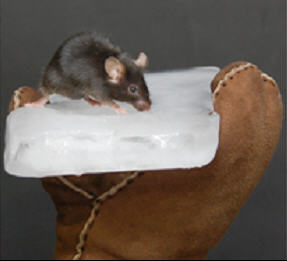Freeing knotted shoelaces with fingers that are frozen stiff is extremely difficult and can even be painful. The reason that sensitivity and dexterity are poor is that both nerves and muscles perform their tasks reluctantly when they are cold.
Nevertheless ice-cold fingers ache and do so all the more in response to the lightest of knocks or squeezing. As unpleasant as this is, it serves as protection against frost lesion. The question of how pain can still be registered despite the otherwise hampered function during cooling has recently been explained.
They have demonstrated that the endings of nerves normally involved in signaling pain are equipped with a frost tolerant igniter of nerve impulses.

In order to function properly nerve fibres and their endings must generate a small, but explosively rapid, electrical sodium current known as a nerve impulse (action potential). The sluices for this, the sodium channels, open and close more slowly when cooled and also become more likely to be literally ‘frozen’ in a state known as ‘slow inactivation’.
Pain signaling nerves however possess a rather special sodium channel subtype, the NaV1.8, which also becomes more sluggish with cooling but can resist the entry into slow inactivation and thus the channel is in a position to still generate action potentials at 10°C skin temperature.
The NaV1.8 sodium channel is also renowned for being resistant to blockade by a toxin found in the tasty, albeit for Sushi too expensive, Pacific Fugu fish. The bacterially derived substance from the fish´s entrails known as Tetrodotoxin (TTX) blocks most other sodium channels and in doing so can be fatal to the gourmet even at very low doses. A second feature of NaV1.8 is that it is found exclusively in the nerve endings and cell bodies of pain signaling nerves, called ‘nociceptors’. Nociceptors normally use the TTX-sensitive sodium channels to signal pain. To rescue their function from cold block NaV1.8 channels are recruited so that pain from the extremities can still be registered.
Normally, the excitability of these nerve fibres is rather independent of NaV1.8 because its threshold for activation is too high. During cooling however the electrical resistance of the neuronal cell membrane increases. This means that the isolation between the inside and the outside of the cell is better and as such less of the small sodium flow in the nerve ending is lost to a short circuit. In this way, the high threshold of NaV1.8 is reached and its rescue function can be realized.
Implications for pain medication
The restriction of NaV1.8 to nociceptors that register pain has made this sodium channel an attractive target for the pharmaceutical industry. The hope being that blockade of this channel could selectively block pain without side-effects. This made the disappointment all the more poignant when eight years ago Prof. John Wood´s group (UCL) succeeded in removing the NaV1.8 from the genetic code of mice only to discover that this deficit resulted in hardly any change in sensitivity to various forms of painful stimulation.
It was only the response to painful cold that was not tested in these animals and this omission has now been filled in the current work. The experiments this time showed that in the wild such animals would be in danger, since they feel cold but are unable to register cold-induced pain.
Very recently, the American companies Abbott and Icagen reported a possible future medication directed against pain (Jarvis et al., 2007, PNAS) that preferentially blocks NaV1.8. This substance works particularly well in animal experiments against ‘cold allodynia’, a form of over-sensitivity to cold that can occur after damage to peripheral nerves. The research from the Erlangen group explains this action.
This research advance was made possible by the collaborative work of the research group of Professor Peter Reeh at the Institute of Physiology and Pathophysiology together with the anaesthesiologists Dr. Andreas Leffler and Professor Carla Nau, that began as part of the Special Research Program (DFG-SFB 353) “Pathobiology of the origin and processing of pain”. The research in the Anaesthesiology Department at the Erlangen University Clinic is now supported by the German Research Society (Focusgroup KFO130).
Sensory neuron sodium channel Nav1.8 is essential for pain at low temperatures, Katharina Zimmermann1,6, Andreas Leffler2,6, Alexandru Babes1,3, Cruz Miguel Cendan4, Richard W. Carr1, Jin-ichi Kobayashi5, Carla Nau2, John N. Wood4 & Peter W. Reeh1




Comments